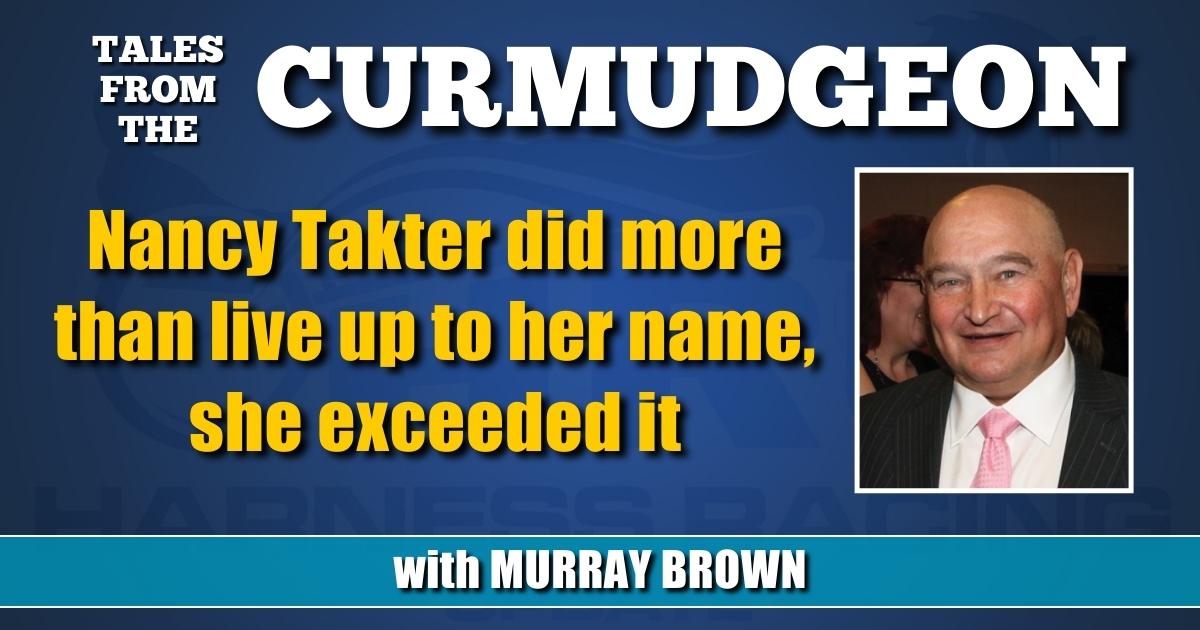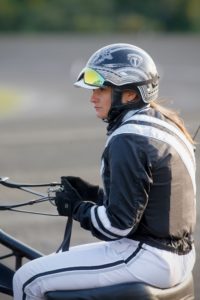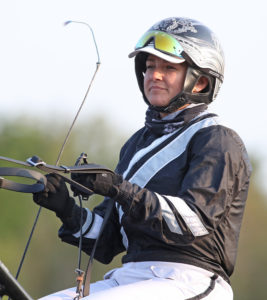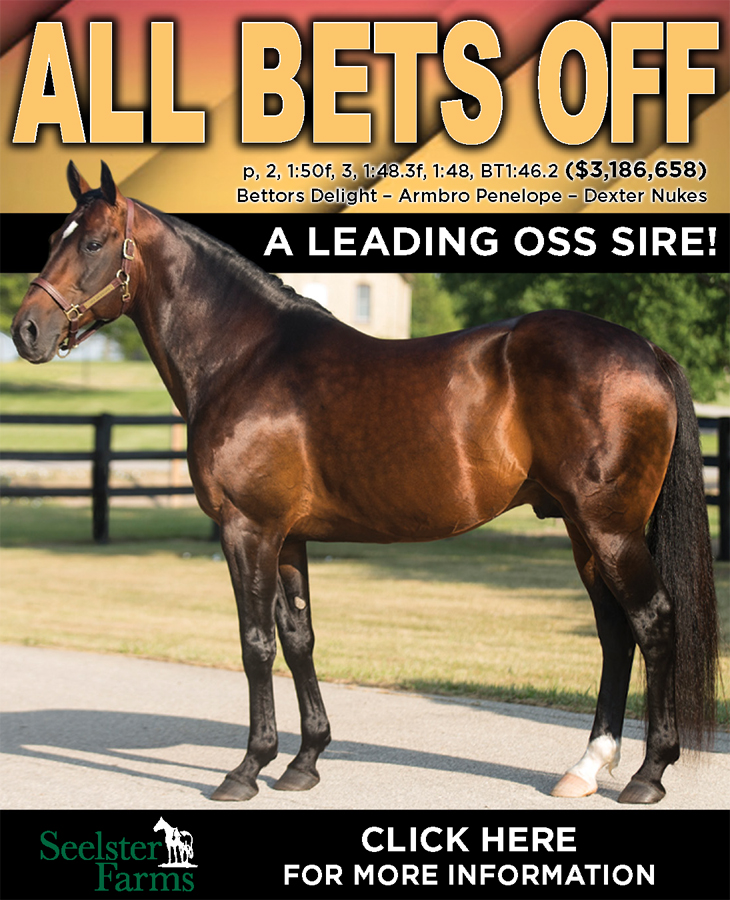

Nancy Takter did more than live up to her name, she exceeded it
A conversation with the ultra-talented daughter of a legend.
by Murray Brown
Being a direct descendant of a great person can either be a blessing or a slight burden. Are the expectations too high? Perhaps somewhat, but not absolutely. From where I sit, the plusses undoubtedly outnumber the minuses. One gets the opportunity to start at a spot somewhere removed from the very beginning.
For as long as she can remember, Nancy Takter was always involved with horses. In some instances, it was just tagging along after her dad the triple hall of famer Jimmy Takter or her mom, Christina. Make no mistake about it, Christina Takter is an integral component of her husband’s success, one might even say his domination in world-wide trotting.
It began 40 years ago in Malmo, Sweden where Nancy was born. She accompanied her parents as a one-year-old toddler across the Atlantic in December 1982 when they decided their future lay in America. Although, she could claim dual citizenship, there is no doubt that she is and most definitely considers herself to be an American.
Take us through time from when you arrived in this country to where you are now.
“For all intents and purposes, dad was born a horseman. He probably had no other choice, nor certainly did he aspire to become anything else. Dad and mom were part of the great Swedish migration to America of the 1980s. Although they were born and raised in Sweden, they have lived and prospered as Americans from the beginning. Dad was born into the game. His father, Bo William, was considered one of the great trotting trainers in Sweden. Dad started working for the great Swedish horse trainer Soren Nordin when he arrived on these shores. He quickly outperformed the role of apprentice and decided to go out on his own shortly thereafter. It wasn’t quite ‘instant’ success, but it didn’t take too long before he became known as one of North America’s best conditioners. Hard work and great talent quickly propelled the Takters up the totem pole.
“I was ‘Dad’s Shadow.’. It seemed like wherever and whenever he went, I was along with him. I consider myself to be a great observer. I watched him all the time. I quickly adapted a good many of the habits and the philosophy that led him to become the Jimmy Takter that he became. I was with him from the beginning, first as a tagalong, then as a groom in his stable and then as a groom with some second trainer responsibilities in his operation. I was usually there picking up on all the knowledge that was available.”
Your dad had decided to retire and you decided to branch out on your own.
“When my dad retired, I already had over 30 horses in training and was established as a trainer on my own. At that point, I had already trained JK Shesalady, Kissin In The Sand and Captain Crunch. With my dad’s retirement, came the opportunity to grow my stable and to also take over the family training center which has been a huge advantage for me. I also ‘inherited‘ some nice horses like Manchego, Don’t Let’em and The Ice Duchess. With his retirement also came support from some of his biggest owners like Black Horse Racing, Katz/Libfeld, John Fielding and my mom Christina Takter. Josert Fonseca and Conny Svensson were part of my dad’s staff that made the move over to my stable along with some outstanding caretakers. My dad being in retirement and no long competing opened up the door for him to be there to give me advice when I needed it. Dad and I are very competitive. When he was running his own stable, yes, he wanted me to do well… [But] no he didn’t want to lose even to me.
“I originally went on my own in 2013 feeling that life had more to offer me than to be a caretaker for the rest of my life. Perry Soderberg gave me my first yearling to train, a $7,000 yearling named Western Vintage. Western Vintage ended up being one of the best 2-year-olds of his year. Around the same time, the 3 Brothers Stables were looking for a trainer. They reached out to me. Alan, Steven and Ronnie Katz sent me their homebreds that year. Among them was JK Shesalady. She ended up being undefeated and winning Horse of the Year honors in both Canada and the United States.
“I’d be disingenuous if I didn’t say that I found myself in a situation where I didn’t have a whole lot going for me. I was coming out of an ‘apprenticeship‘ with the foremost Grand Circuit racing stable in America and probably the world. In addition to all the experience I had garnered from working at Jimmy Takter’s side, I also had access to some of his great help, his great owners and perhaps even a few horses that I ’inherited’ from my father. Not only all of that, but also the knowledge that I could call upon dad for advice in virtually any horse related situation. I would also be setting up headquarters at what I believe to be the finest horse training facility in North America.”
What is it about your dad that contributed to his becoming not only great, but one of the very few all-time greats in the history of our sport?
“There are undoubtedly numerous factors and positives. However, in my opinion, the greatest one is that he genuinely loves horses. He loves them all to probably varying degrees. He can transport himself into their very essence. It’s not only the big things, but also a great deal of the minutia. All of those little things eventually add up to a great whole. He looks upon himself as being an artist tasked with creating masterpieces.”
You are now in the 10th year of being out on your own. How do you view your stable at present?
“We are training 55 head of which 30 are 2-year-olds. There is about a three to one ratio of pacers to trotters. At this point I’m very pleased with what we have. However, it’s not quite May yet and we’ve only gone between 2:07 and 2:11 with them. I would say that we would be in a pretty sad state if I were not pleased with where we are at this point.”
Do you have any favorites right now?
“Not really. But I think they are a pretty substantial group. There’s a Father Patrick filly out of Shake It Cerry, Cheval Rapide, that appears to be quite talented. The full brother to Tall Dark Stranger, Total Stranger, seems to have a good deal of go. We have seven 2-year-olds from the first crop by Captain Crunch. I like them as a group. At this point there are none that I look upon as laggards.”
Of all the horses that you have trained, do you look upon any of them as favorites?
“If I were looking to pick just one, that one would be Kissin In The Sand. From the outset she was an extremely difficult filly with which to work. She had issues all along. She wasn’t the easiest filly both physically and in temperament. With the former, she was constantly bothered by allergies. She wanted to do things as she pleased. I wanted her to do them my way. After a good deal of trial and error we reached an accommodation. From that point forward she became a sweetheart. I remember a conversation I had with Marvin Katz, one of her owners, early in the game. I told Marvin, ‘This filly is either going to become a champion or a discard.’ Thankfully, the former transpired.
“Of course, there are others, fortunately quite a few others. One of them is Tall Dark Stranger whose first crop of yearlings we are anxiously awaiting. If they are anything like he was, they will be great. He had it all. He was perhaps the most beautiful yearling that I’ve ever seen. From the onset, he trained like a good horse. He not only trained like one, more importantly he raced like one both at 2 and 3. The only regret I have about him is that his 3-year-old season coincided with the worst of COVID. Probably not as many people as could have got to see him race.”
How about your life away from the horses? Do either of your two kids show any interest?
“Away from the horses I like to eat good food. Fortunately, I also enjoy exercising. I enjoy fashion and shopping and try to stay current on what’s going on in the ’real world.’ My oldest, Ella, will be attending college this year at WPI. She is interested in pursuing a career in aerospace engineering and computer science. My son, Marcus, is still in high school. His two greatest pursuits at the moment are in playing hockey and golf… I could maybe see him having some interest in the sport as he gets older.”
How does your training operation work?
“I like to say that I don’t train like everybody else. But the truth of the matter is that we do not train much differently than my dad did. If you were going to classify it, you might say that we emphasize conditioning far more than we do speed. My experience is that speed will come as a natural sequence of conditioning. I think that our 2-year-olds have just reached the stage where they are becoming more competitive. The competitive spirit leads to speed. It will come when it does.”
Do you have any favorite tracks where you like to race?
“The three top ones in order would be The Meadowlands, Lexington and Mohawk. The Meadowlands because its home for us. This is the track where we probably spend most of our time. Its where I grew up and learned most everything that I know. We start our season racing and often end it racing here. The Red Mile in Lexington is great, especially so for the owners and maybe the horses, but probably not so much for the trainers. There is so much to do and often nowhere near enough time in which to do it. We’ve got to train our horses, manage them, go out to the farms and look at yearlings, race in the afternoons, socialize with owners and often go to the sales in the evenings. Two weeks of doing this just about every day can be very draining. I love racing at Mohawk mostly because of the hospitality of management up there. When you race there, you feel like you are truly welcome and appreciated. Another factor is the fans. It remains one of the very few places where the customers come out to cheer for and appreciate good horses.”
Are the horses of today any different than those you grew up with?
“For the most part I would say yes. They are faster, better gaited and come to their speed a whole lot quicker. I would say that they are generally better individuals as well. I guess that is a tribute to the breeders and to the evolution of our breed. There are far fewer yearlings at the major sales that you can eliminate due to obvious conformation defects. That is undoubtedly true, but there are lameness and breathing issues that continue to affect us.”
Talk a little about your owners.
“I’m very privileged to have a great group of them. Mom and dad have backed me from the onset. There are others such as Black Horse Racing, Marvin Katz, Al Libfeld, the Chafees, the folks from Crawford Farms, the Katz Brothers, John Fielding, Howard Taylor, Joe Sbrocco, John Fodera and others that do not come immediately to mind. I like to think that I have good relationships with all of them.”
Insofar as owners are concerned, do you speak with them often?
“It varies from client to client. I speak with Alan Katz almost every day. I do try to keep communication open with all of them and try to keep them apprised with the progress of their horses. I make it a point to sit behind every horse in the stable at least once a week. I believe that most of our stable members have pretty much the same philosophy as I do with regard to the horses. We place a high priority on quality over quantity.”

















